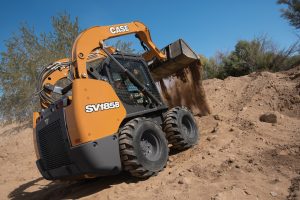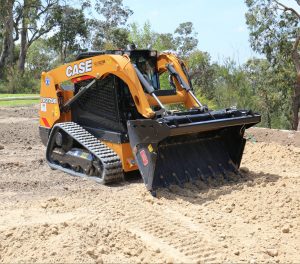Skid steers and compact track loaders are found on nearly every construction site, thanks to their versatility and compact build. Landscapers, civil plumbers, construction workers and even farmers find use for skid steers and compact track loaders.
Skid steers and track loaders both perform similar tasks, but the subtle differences between the two can add increased productivity and profitably for your job site, depending on your budget, location and task.
Appearances and Controls
On appearances, skid steers are obviously run on tyres while track loaders feature a tracked design. Both a skid steer and a track loader can operate in tight spaces and can turn sharp, narrow corners with ease.
CASE skid steer loaders and track loaders are both built with electro-hydraulic controls, which makes it easier than ever to customise each machine to application/operator preference. With the ability to switch between H and ISO patterns, CASE skid steer loaders and track loaders are both safe and simple to operate.
Track Loader & Skid Steer Sizes
Track loaders tend to carry a bit more weight than a skid steer, something to consider if transporting your machine is a factor.
The smaller skid steer models are narrower than their track loader counterparts, making them ideal for tight access areas.
Comfort and Cab design
For a smoother ride, the Case track loaders are generally more comfortable, thanks to the smoothness of the tracks compared to the unforgiving nature of a skid steer.
Operators in Case skid steers and track loaders will have the best perspective of the job site, with cab-wide rear-view mirror, large front and side windows, a low entry threshold for greater visibility down to the bucket and a low sloping rear hood.
In addition, the new Case skid steers and track loaders feature an 8-inch LCD multi-function display, with a reversing camera for optimal vision.
Where are you working?
Every job site is different, and the surface you’re working on can influence the time and energy spent doing a job properly.
On softer surfaces, track loaders have the advantage of causing less damage underfoot on sites, while skid steers’ tyres can lead to the earth being churned over and more sit clean-up at the end of the project.
However, skid steers have an edge on harder surfaces like asphalt, as they can operate here without the risk of damage. Track loaders will run into the risk of wearing down their tracks over time on these harsher surfaces, leading to a lack of control and loss of productivity.
But when faced with uneven or sandy conditions, track loaders come out on top, as they boast increased stability. And in muddy or wet terrain, track loaders are more likely to perform with increased breakout force than skid steers.
Maintenance
Both tyres and tracks will need to be checked regularly in order to avoid damages and breakdowns on site. Getting the best quality parts for your machine is crucial, therefore having the right Parts Team on your side is a necessity.
A rubber-tyred skid steer is better suited for working on improved surfaces (asphalt, concrete, hard-packed rock/gravel) as the tyres will generally last longer than rubber tracks on these surfaces, and cost less to replace than rubber tracks when they do wear and/or fail. With a larger continuous square footage in constant contact with the ground, the rubber track and the undercarriage itself is more susceptible to abrasive wear and vibration, and therefore faster replacement rates.
Remember that proper operating procedures start before the machine gets to the jobsite. Check the ground conditions and the terrain to make a number of informed decisions (if you have numerous machines/track styles to choose from); such as the need to minimise travel and the use of steel tracks versus rubber tracks depending on the need to control ground pressure or navigate debris.
In summary, Case track loaders and Case skid steers each serve important roles on various job sites. Although each have their advantages, they are both built on more than 50 years of engineering and field know-how to provide the most intuitive operator experience and comfortable working environment
If you ever need more information on what machine is right for you, speak to an expert and give our team a call.



